View in other NatureServe Network Field Guides
NatureServe
Montana
Utah
Wyoming
Idaho
Wisconsin
British Columbia
South Carolina
Yukon
California
New York
Weber's Saw-wort - Saussurea weberi
State Rank Reason (see State Rank above)
Known from one large occurrence in the Anaconda-Pintler Range in the alpine zone. The remote, high-elevation habitat should greatly minimize the potential for any negative impacts to the viability of the species in the state. Population estimates from the single, documented occurrence vary widely. Additional population data are needed.
- Details on Status Ranking and Review
Population Size
Score2-3 - Very Small to Small: Population size is imprecisely known but is believed to be <10,000 individuals.
Range Extent
Score2 - Regional or State Endemic or Small Montana Range: Generally restricted to an area <100,000 sq. miles (equivalent to 2/3 the size of Montana or less) or Montana contributes 50% or more of the species’ range or populations OR limited to 2-3 Sub-basins in Montana.
Area of Occupancy
Score3 - Very Low: Generally occurring in 3 or fewer Subwatersheds (6th Code HUC’s).
Environmental Specificity
Score1-2 - Moderate to High.
Trends
ScoreNA - Rank factor not assessed.
CommentTrends unknown though populations are likely stable or experiencing only minor declines.
Threats
Score0-1 - Low to Medium.
Intrinsic Vulnerability
Score1 - Moderate Vulnerability: Specific biological attributes, unusual life history characteristics or limited reproductive potential makes the species susceptible to extirpation from stochastic events or other adverse impacts to its habitat and slow to recover.
Raw Conservation Status Score
Score
9 to 12 total points scored out of a possible 16 (Rarity factors and threats only).
General Description
Weber's Saw-wort is a dwarf perennial herb that is 5-20 cm high and arising from a woody rootstock. The lance-shaped leaf blades are coarsely toothed, up to 8 cm long, and have a broad petiole. The alternate leaves are crowded on the stem, reduced, and lacking petioles towards the top. Herbage is covered with long, tangled hairs when young but becomes glabrous with age. The purple flowering heads are borne in a dense cluster subtended by leaves at the top of the stem. The broad involucral bracts of the heads have rounded tips and are 11-15 mm long. All of the flowers are tubular (disk flowers); ray flowers are absent. The achene has a pappus on top.
Phenology
Flowering in July-early August.
Diagnostic Characteristics
The clustered, purple, rayless flowering heads, together with the high elevation habitat, are distinctive. The similar S. densa, occurring in the northwest mountains, has narrow, pointed involucral bracts.
Species Range
Montana Range
Range Descriptions
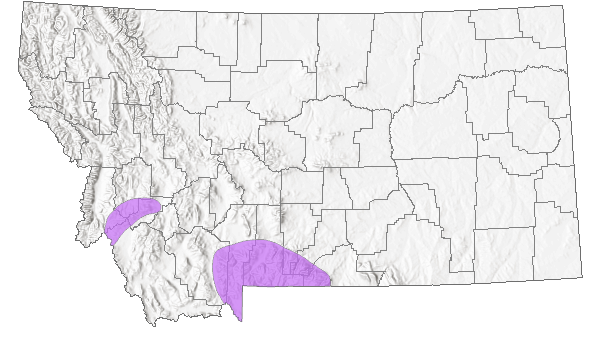
 Native
Native
Range Comments
Regional endemic of southwest Montana, northwest Wyoming, and central Colorado.
Observations in Montana Natural Heritage Program Database
Number of Observations: 9
(Click on the following maps and charts to see full sized version)
Map Help and Descriptions
Relative Density
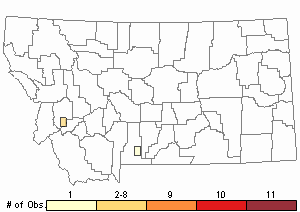
Recency
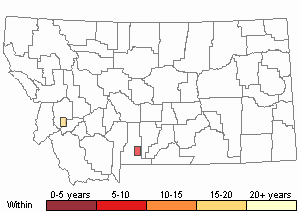
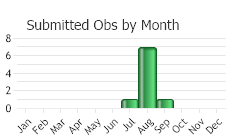
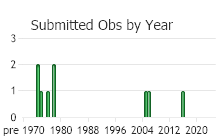
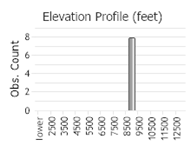 (Observations spanning multiple months or years are excluded from time charts)
(Observations spanning multiple months or years are excluded from time charts)
Habitat
Moist meadows in the alpine zone.
National Vegetation Classification System Groups Associated with this Species
Alpine
Alpine - Vegetated
Wetland and Riparian
Alpine Riparian and Wetland
Stewardship Responsibility
Threats or Limiting Factors
STATE THREAT SCORE REASON
Threat impact not assigned because threats are not known (MTNHP Threat Assessment 2021).
References
- Literature Cited AboveLegend:
 View Online Publication
View Online Publication MTNHP Threat Assessment. 2021. State Threat Score Assignment and Assessment of Reported Threats from 2006 to 2021 for State-listed Vascular Plants. Botany Program, Montana Natural Heritage Program, Helena, Montana.
MTNHP Threat Assessment. 2021. State Threat Score Assignment and Assessment of Reported Threats from 2006 to 2021 for State-listed Vascular Plants. Botany Program, Montana Natural Heritage Program, Helena, Montana.
- Additional ReferencesLegend:
 View Online Publication
View Online Publication
Do you know of a citation we're missing? Achuff, P. L. and L. S. Roe. 1992. Botanical survey of the Goat Flat proposed Research Natural Area, Deerlodge National Forest. Unpublished report to the Deerlodge National Forest. Montana Natural Heritage Program, Helena, MT. 31 pp.
Achuff, P. L. and L. S. Roe. 1992. Botanical survey of the Goat Flat proposed Research Natural Area, Deerlodge National Forest. Unpublished report to the Deerlodge National Forest. Montana Natural Heritage Program, Helena, MT. 31 pp. Lackschewitz, K. H. 1976. Montana mountain flora: new records. Madrono 23:360-362.
Lackschewitz, K. H. 1976. Montana mountain flora: new records. Madrono 23:360-362. Lesica, P., M.T. Lavin, and P.F. Stickney. 2012. Manual of Montana Vascular Plants. Fort Worth, TX: BRIT Press. viii + 771 p.
Lesica, P., M.T. Lavin, and P.F. Stickney. 2012. Manual of Montana Vascular Plants. Fort Worth, TX: BRIT Press. viii + 771 p. Lesica, P., M.T. Lavin, and P.F. Stickney. 2022. Manual of Montana Vascular Plants, Second Edition. Fort Worth, TX: BRIT Press. viii + 779 p.
Lesica, P., M.T. Lavin, and P.F. Stickney. 2022. Manual of Montana Vascular Plants, Second Edition. Fort Worth, TX: BRIT Press. viii + 779 p. Marriott, H. 1991. Field survey for Androsace chamaejasme var. Carinata and Saussurea weberi, Northwest Wind River Range, Wyoming. Unpublished report to the Bridger-Teton National Forest. Wyoming Natural Diversity Database, The Nature Conservancy. 21 pp.
Marriott, H. 1991. Field survey for Androsace chamaejasme var. Carinata and Saussurea weberi, Northwest Wind River Range, Wyoming. Unpublished report to the Bridger-Teton National Forest. Wyoming Natural Diversity Database, The Nature Conservancy. 21 pp. Watson, T.J. and K.H. Lackschewitz. 1980. The genus Saussurea (Asteraceae-Cynareae) in Montana. Northwest Science 54(2):106-108.
Watson, T.J. and K.H. Lackschewitz. 1980. The genus Saussurea (Asteraceae-Cynareae) in Montana. Northwest Science 54(2):106-108.
- Web Search Engines for Articles on "Weber's Saw-wort"





